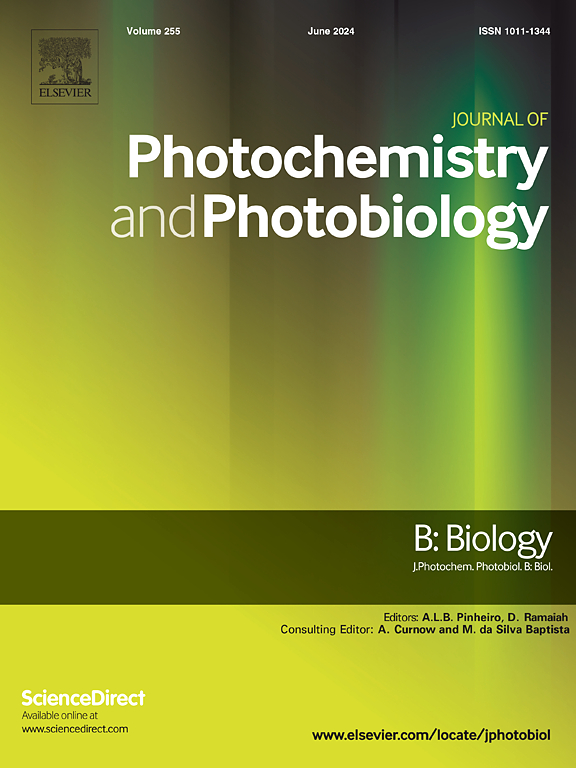Metataxonomy 和色素分析揭示了奥迪尔盐湖(西班牙西南部)不同盐度下微生物的多样性和基于视网膜的光能营养相关性。
IF 3.9
2区 生物学
Q2 BIOCHEMISTRY & MOLECULAR BIOLOGY
Journal of photochemistry and photobiology. B, Biology
Pub Date : 2024-10-17
DOI:10.1016/j.jphotobiol.2024.113043
引用次数: 0
摘要
盐度对微生物的分布模式有很大影响,因此对光异养新陈代谢的相关性也有很大影响,自从发现蛋白光蛋白以来,光异养新陈代谢被认为是海洋表面捕获太阳能的主要因素。日光盐场是同时研究几种盐浓度的特殊系统,从海水(地球上最丰富的环境)到饱和盐水(最极端的环境之一),几乎没有对其进行过研究。本研究通过分光光度法和 RP-HPLC 分析了盐度梯度上的色素组成,并通过针对 16S 和 18S rRNA 基因超变区的元分类研究评估了盐度对三个生命领域微生物多样性的影响。此外,根据叶绿素 a 和视网膜含量,我们估算了视网膜蛋白和光合反应中心的相对丰度,得出视网膜/叶绿素 a 比值与盐度之间存在密切联系的结论。基于视网膜的光合作用对于原核生物在高盐度环境中的生存尤为重要,其作用超过了光合作用捕获的阳光能量,而且随着盐度的增加,这种作用的相关性更大。这一事实对了解微生物在极端条件下的生存以及日晒盐池的能量动态具有重要意义。本文章由计算机程序翻译,如有差异,请以英文原文为准。

Metataxonomy and pigments analyses unravel microbial diversity and the relevance of retinal-based photoheterotrophy at different salinities in the Odiel Salterns (SW, Spain)
Salinity has a strong influence on microorganisms distribution patterns and consequently on the relevance of photoheterotrophic metabolism, which since the discovery of proteorhodopsins is considered the main contributor to solar energy capture on the surface of the oceans. Solar salterns constitute an exceptional system for the simultaneous study of several salt concentrations, ranging from seawater, the most abundant environment on Earth, to saturated brine, one of the most extreme, which has been scarcely studied. In this study, pigment composition across the salinity gradient has been analyzed by spectrophotometry and RP-HPLC, and the influence of salinity on microbial diversity of the three domains of life has been evaluated by a metataxonomic study targeting hypervariable regions of 16S and 18S rRNA genes. Furthermore, based on the chlorophyll a and retinal content, we have estimated the relative abundance of rhodopsins and photosynthetic reaction centers, concluding that there is a strong correlation between the retinal/chlorophyll a ratio and salinity. Retinal-based photoheterotrophy is particularly important for prokaryotic survival in hypersaline environments, surpassing the sunlight energy captured by photosynthesis, and being more relevant as salinity increases. This fact has implications for understanding the survival of microorganisms in extreme conditions and the energy dynamics in solar salter ponds.
求助全文
通过发布文献求助,成功后即可免费获取论文全文。
去求助
来源期刊
CiteScore
12.10
自引率
1.90%
发文量
161
审稿时长
37 days
期刊介绍:
The Journal of Photochemistry and Photobiology B: Biology provides a forum for the publication of papers relating to the various aspects of photobiology, as well as a means for communication in this multidisciplinary field.
The scope includes:
- Bioluminescence
- Chronobiology
- DNA repair
- Environmental photobiology
- Nanotechnology in photobiology
- Photocarcinogenesis
- Photochemistry of biomolecules
- Photodynamic therapy
- Photomedicine
- Photomorphogenesis
- Photomovement
- Photoreception
- Photosensitization
- Photosynthesis
- Phototechnology
- Spectroscopy of biological systems
- UV and visible radiation effects and vision.

 求助内容:
求助内容: 应助结果提醒方式:
应助结果提醒方式:


